HIV/AIDS in Australia: A Report on AIDS Trust Initiatives
VerifiedAdded on 2022/09/26
|16
|2451
|21
Report
AI Summary
This report provides a comprehensive overview of the AIDS Trust of Australia's response to the HIV/AIDS epidemic in Australia. It begins with an introduction and historical overview, highlighting the country's swift governmental action and effective public health programs. The report details the organization's background, achievements, and the success of its initiatives. It delves into the challenges of HIV/AIDS, including stigma and discrimination, and outlines various strategies to combat these issues. The report also explores social issues, such as the impact on individuals and communities, and the importance of education, anti-discrimination laws, and empowerment. The conclusion emphasizes the significance of the AIDS Trust's work, the importance of human rights, and the need to eradicate barriers to testing and treatment to end the global HIV epidemic. The report references key organizations and publications, providing a thorough analysis of the subject.

Introduction to social work and human services
Paraphrase This Document
Need a fresh take? Get an instant paraphrase of this document with our AI Paraphraser
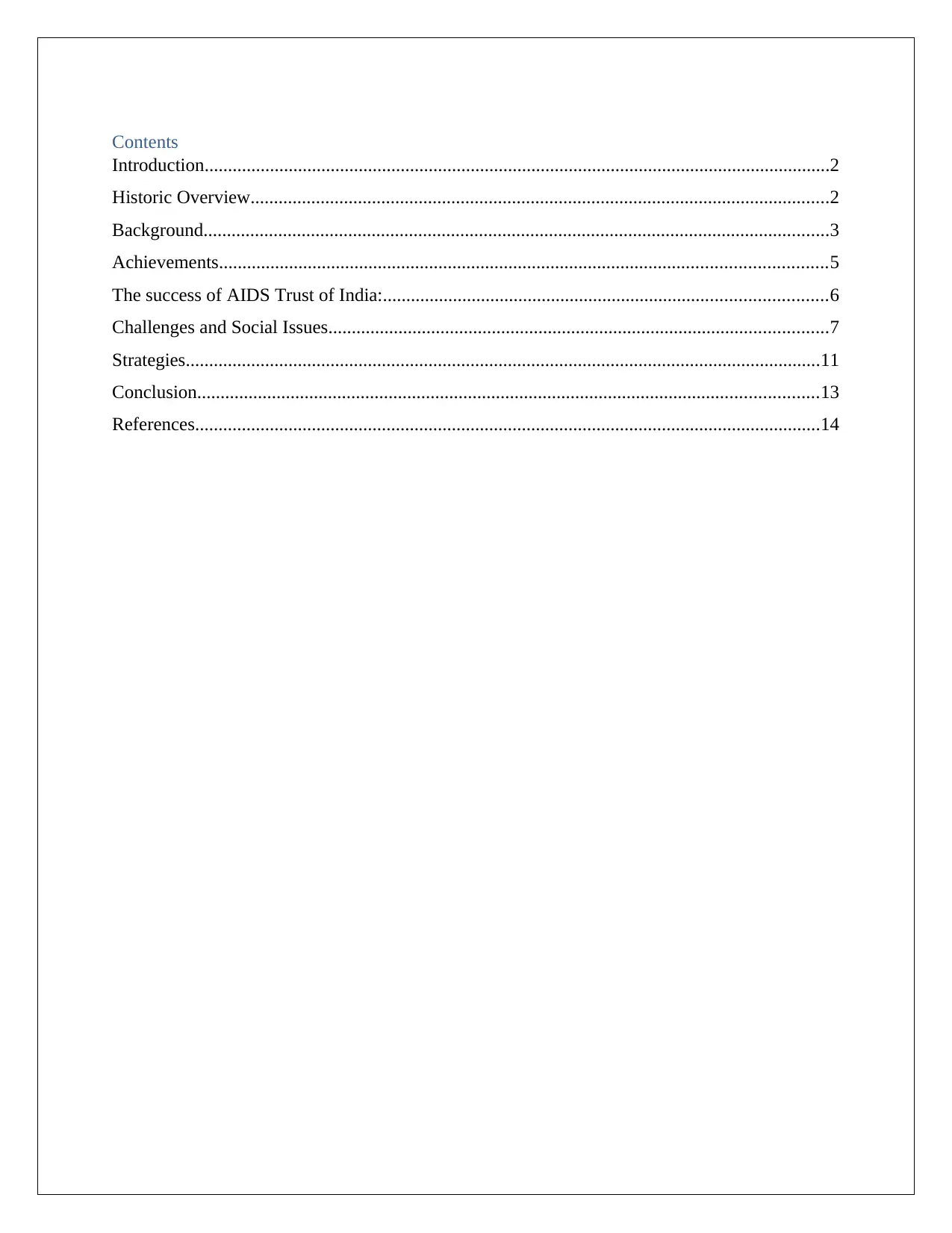
Contents
Introduction......................................................................................................................................2
Historic Overview............................................................................................................................2
Background......................................................................................................................................3
Achievements..................................................................................................................................5
The success of AIDS Trust of India:...............................................................................................6
Challenges and Social Issues...........................................................................................................7
Strategies........................................................................................................................................11
Conclusion.....................................................................................................................................13
References......................................................................................................................................14
Introduction......................................................................................................................................2
Historic Overview............................................................................................................................2
Background......................................................................................................................................3
Achievements..................................................................................................................................5
The success of AIDS Trust of India:...............................................................................................6
Challenges and Social Issues...........................................................................................................7
Strategies........................................................................................................................................11
Conclusion.....................................................................................................................................13
References......................................................................................................................................14

Introduction
AIDS has a distinctive history in Australia. The government bodies of Australia acted related
swiftly to the AIDS pandemic than the rest of the world. They recognized and responded with
the effective implementation of prevention of disease and through public health programs like
needle and syringe programs (NSP's) resulting in maintaining the low rate of HIV infection in
Australia as compared to the rest of the world. Though the number of group members who are at
risk who contracted the infection, in the beginning, were significant. The country managed to
maintain a low infection rate in Australia. There were approximately 27,545 estimated cases in
the year 2017 who were living with HIV/AIDS (Acquired Immunodeficiency Syndrome). There
were approximately 20,000 who were having male to male exposure to sex, 6200 cases
accounted for heterosexual sex and 600 cases due to usage of drug injection and 170 cases that
account for other exposures like healthcare setting, blood/tissue recipient, vertical transmission
to new-born, etc. The first case of HIV/AIDS was recorded in the year 1982 in Sydney (Aids
Trust Australia, 2020).
Historic Overview
HIV is a complex medical condition that is demanding and needs proper attention. The several
challenges involving a blend of social, cultural, religious, legal, political and geographical comes
in the way of prevention, transmission and supporting people affected by HIV. The Australian
response to HIV is characterized by great skill, great resolve and great generosity. To support
and improve the care, the committed relationship is provided by the government, civil society,
affected communities, and the private sector. Due to education, awareness, research and
prevention programs the HIV prevalence has been low in Australia (Goodcompany Enterprises,
AIDS has a distinctive history in Australia. The government bodies of Australia acted related
swiftly to the AIDS pandemic than the rest of the world. They recognized and responded with
the effective implementation of prevention of disease and through public health programs like
needle and syringe programs (NSP's) resulting in maintaining the low rate of HIV infection in
Australia as compared to the rest of the world. Though the number of group members who are at
risk who contracted the infection, in the beginning, were significant. The country managed to
maintain a low infection rate in Australia. There were approximately 27,545 estimated cases in
the year 2017 who were living with HIV/AIDS (Acquired Immunodeficiency Syndrome). There
were approximately 20,000 who were having male to male exposure to sex, 6200 cases
accounted for heterosexual sex and 600 cases due to usage of drug injection and 170 cases that
account for other exposures like healthcare setting, blood/tissue recipient, vertical transmission
to new-born, etc. The first case of HIV/AIDS was recorded in the year 1982 in Sydney (Aids
Trust Australia, 2020).
Historic Overview
HIV is a complex medical condition that is demanding and needs proper attention. The several
challenges involving a blend of social, cultural, religious, legal, political and geographical comes
in the way of prevention, transmission and supporting people affected by HIV. The Australian
response to HIV is characterized by great skill, great resolve and great generosity. To support
and improve the care, the committed relationship is provided by the government, civil society,
affected communities, and the private sector. Due to education, awareness, research and
prevention programs the HIV prevalence has been low in Australia (Goodcompany Enterprises,
⊘ This is a preview!⊘
Do you want full access?
Subscribe today to unlock all pages.

Trusted by 1+ million students worldwide

2020). The non-government organizations were formed and have played a prominent role in
addressing the issue of AIDS in Australia. One of the most notable organizations is AIDS Trust
of Australia is formed in the year 1987. AIDS Trust of Australia was established by the then
Governor-General of the Commonwealth of Australia, the Rt Hon. Sir Ninian, AK, KBE, QC,
GCMG, Stephen KG in the year 1987.AIDS Trust of Australia is giving its services in
eradication and combating the illness of HIV and AIDS in Australia.
Background
AIDS Trust of Australia is raising funds for the HIV sector through national charity. It helps in
making the virtual vision of the elimination of HIV transmission a reality. It works with the
mission of enhancing the response of Australia to HIV/AIDS (Auto Immune Deficiency
Syndrome). The organization disperses its funds in community-based organizations for providing
education, support, care and research work related to HIV/AIDS. AIDS Trust of Australia is
having the support of donors, supports, and people struggling with HIV/AIDS. AIDS Trust of
Australia is using a human rights approach towards health. The funds of AIDS Trust of Australia
are raised through bequests, regular giving, workplace giving, annuities, and individual
donations (Commonwealth of Australia, 2005).
AIDS Trust of Australia does not do any projects. They are done by the specialized and
community-specific tasks. The task is done by NAFL (National AIDS Fundraising Limited) and
its other members excel in it. The AIDS Trust of Australia raises funds for them. They fund
projects that are directly related to HIV only.
AIDS Trust of Australia has the sole trustee called National AIDS Fundraising Limited. The
activities and operations of AIDS Trust is managed by NAFL on behalf of its members. The
addressing the issue of AIDS in Australia. One of the most notable organizations is AIDS Trust
of Australia is formed in the year 1987. AIDS Trust of Australia was established by the then
Governor-General of the Commonwealth of Australia, the Rt Hon. Sir Ninian, AK, KBE, QC,
GCMG, Stephen KG in the year 1987.AIDS Trust of Australia is giving its services in
eradication and combating the illness of HIV and AIDS in Australia.
Background
AIDS Trust of Australia is raising funds for the HIV sector through national charity. It helps in
making the virtual vision of the elimination of HIV transmission a reality. It works with the
mission of enhancing the response of Australia to HIV/AIDS (Auto Immune Deficiency
Syndrome). The organization disperses its funds in community-based organizations for providing
education, support, care and research work related to HIV/AIDS. AIDS Trust of Australia is
having the support of donors, supports, and people struggling with HIV/AIDS. AIDS Trust of
Australia is using a human rights approach towards health. The funds of AIDS Trust of Australia
are raised through bequests, regular giving, workplace giving, annuities, and individual
donations (Commonwealth of Australia, 2005).
AIDS Trust of Australia does not do any projects. They are done by the specialized and
community-specific tasks. The task is done by NAFL (National AIDS Fundraising Limited) and
its other members excel in it. The AIDS Trust of Australia raises funds for them. They fund
projects that are directly related to HIV only.
AIDS Trust of Australia has the sole trustee called National AIDS Fundraising Limited. The
activities and operations of AIDS Trust is managed by NAFL on behalf of its members. The
Paraphrase This Document
Need a fresh take? Get an instant paraphrase of this document with our AI Paraphraser
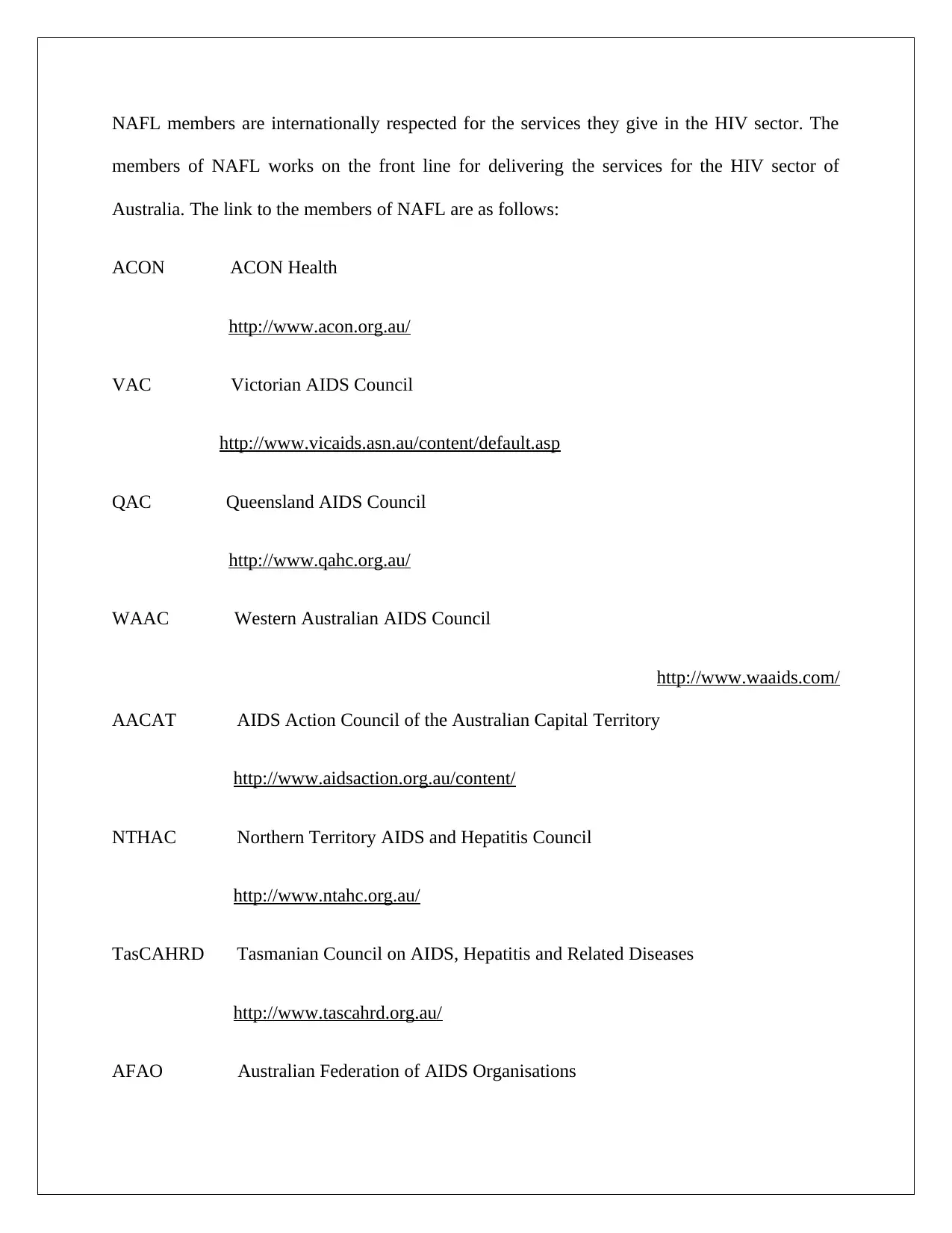
NAFL members are internationally respected for the services they give in the HIV sector. The
members of NAFL works on the front line for delivering the services for the HIV sector of
Australia. The link to the members of NAFL are as follows:
ACON ACON Health
http://www.acon.org.au/
VAC Victorian AIDS Council
http://www.vicaids.asn.au/content/default.asp
QAC Queensland AIDS Council
http://www.qahc.org.au/
WAAC Western Australian AIDS Council
http://www.waaids.com/
AACAT AIDS Action Council of the Australian Capital Territory
http://www.aidsaction.org.au/content/
NTHAC Northern Territory AIDS and Hepatitis Council
http://www.ntahc.org.au/
TasCAHRD Tasmanian Council on AIDS, Hepatitis and Related Diseases
http://www.tascahrd.org.au/
AFAO Australian Federation of AIDS Organisations
members of NAFL works on the front line for delivering the services for the HIV sector of
Australia. The link to the members of NAFL are as follows:
ACON ACON Health
http://www.acon.org.au/
VAC Victorian AIDS Council
http://www.vicaids.asn.au/content/default.asp
QAC Queensland AIDS Council
http://www.qahc.org.au/
WAAC Western Australian AIDS Council
http://www.waaids.com/
AACAT AIDS Action Council of the Australian Capital Territory
http://www.aidsaction.org.au/content/
NTHAC Northern Territory AIDS and Hepatitis Council
http://www.ntahc.org.au/
TasCAHRD Tasmanian Council on AIDS, Hepatitis and Related Diseases
http://www.tascahrd.org.au/
AFAO Australian Federation of AIDS Organisations
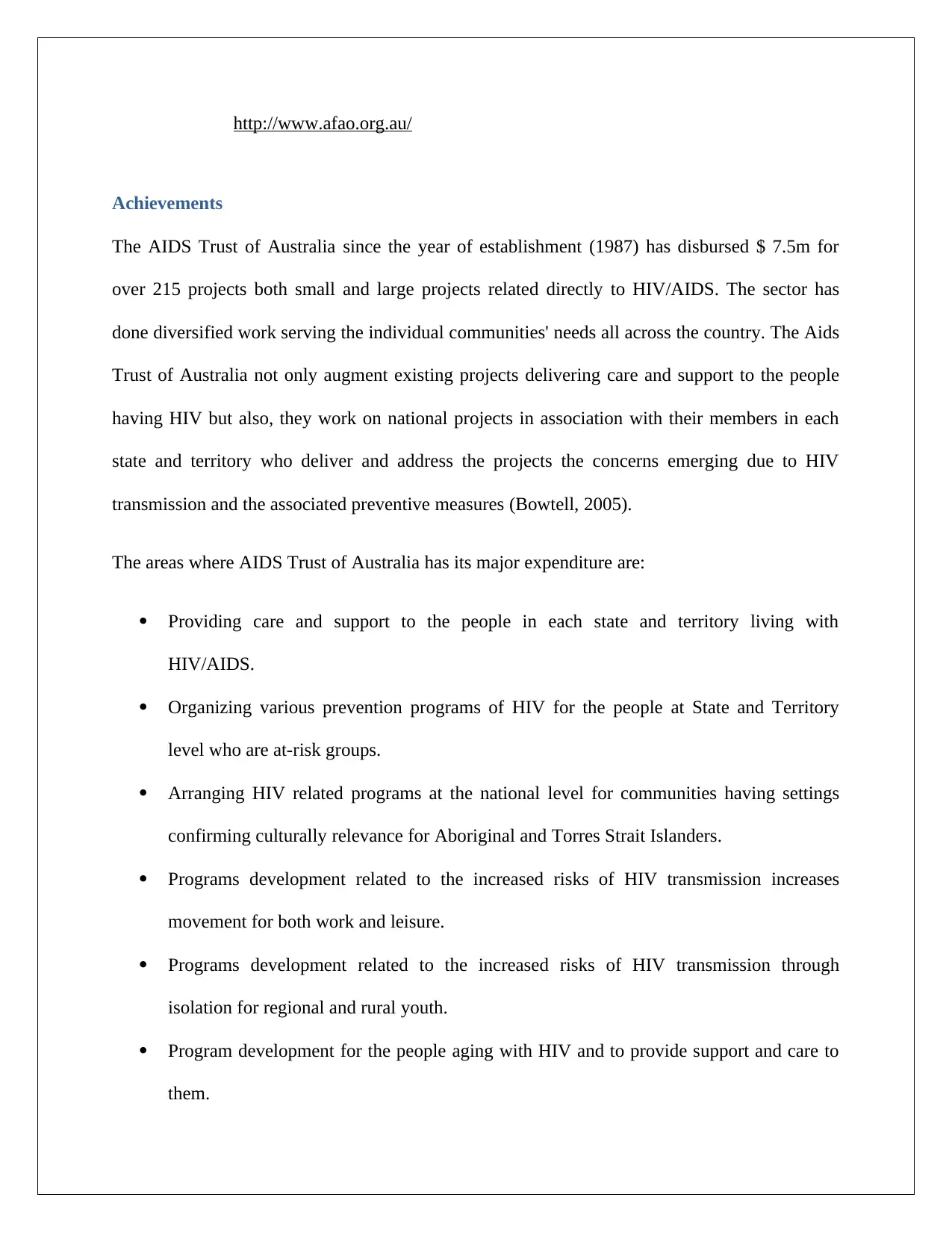
http://www.afao.org.au/
Achievements
The AIDS Trust of Australia since the year of establishment (1987) has disbursed $ 7.5m for
over 215 projects both small and large projects related directly to HIV/AIDS. The sector has
done diversified work serving the individual communities' needs all across the country. The Aids
Trust of Australia not only augment existing projects delivering care and support to the people
having HIV but also, they work on national projects in association with their members in each
state and territory who deliver and address the projects the concerns emerging due to HIV
transmission and the associated preventive measures (Bowtell, 2005).
The areas where AIDS Trust of Australia has its major expenditure are:
Providing care and support to the people in each state and territory living with
HIV/AIDS.
Organizing various prevention programs of HIV for the people at State and Territory
level who are at-risk groups.
Arranging HIV related programs at the national level for communities having settings
confirming culturally relevance for Aboriginal and Torres Strait Islanders.
Programs development related to the increased risks of HIV transmission increases
movement for both work and leisure.
Programs development related to the increased risks of HIV transmission through
isolation for regional and rural youth.
Program development for the people aging with HIV and to provide support and care to
them.
Achievements
The AIDS Trust of Australia since the year of establishment (1987) has disbursed $ 7.5m for
over 215 projects both small and large projects related directly to HIV/AIDS. The sector has
done diversified work serving the individual communities' needs all across the country. The Aids
Trust of Australia not only augment existing projects delivering care and support to the people
having HIV but also, they work on national projects in association with their members in each
state and territory who deliver and address the projects the concerns emerging due to HIV
transmission and the associated preventive measures (Bowtell, 2005).
The areas where AIDS Trust of Australia has its major expenditure are:
Providing care and support to the people in each state and territory living with
HIV/AIDS.
Organizing various prevention programs of HIV for the people at State and Territory
level who are at-risk groups.
Arranging HIV related programs at the national level for communities having settings
confirming culturally relevance for Aboriginal and Torres Strait Islanders.
Programs development related to the increased risks of HIV transmission increases
movement for both work and leisure.
Programs development related to the increased risks of HIV transmission through
isolation for regional and rural youth.
Program development for the people aging with HIV and to provide support and care to
them.
⊘ This is a preview!⊘
Do you want full access?
Subscribe today to unlock all pages.

Trusted by 1+ million students worldwide
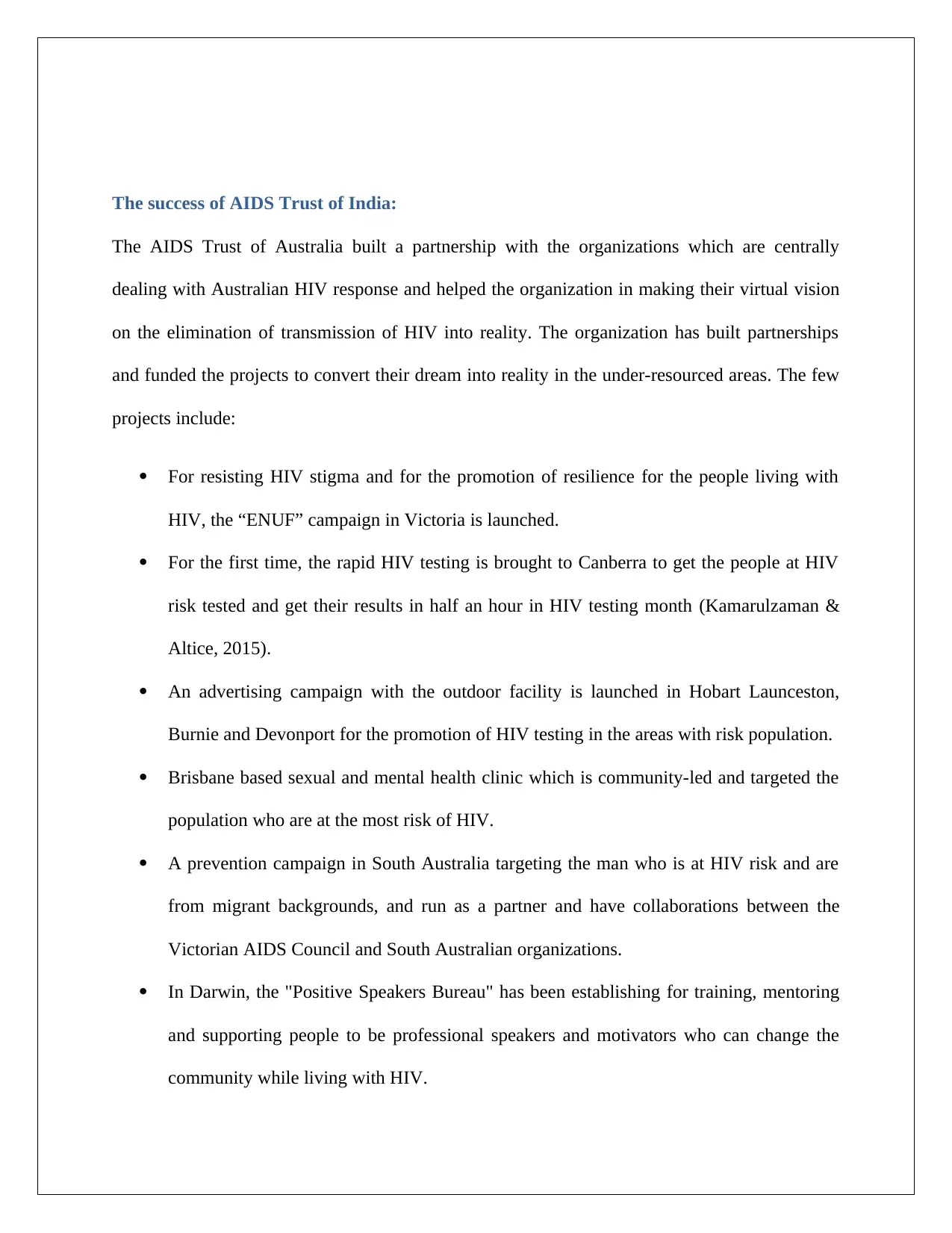
The success of AIDS Trust of India:
The AIDS Trust of Australia built a partnership with the organizations which are centrally
dealing with Australian HIV response and helped the organization in making their virtual vision
on the elimination of transmission of HIV into reality. The organization has built partnerships
and funded the projects to convert their dream into reality in the under-resourced areas. The few
projects include:
For resisting HIV stigma and for the promotion of resilience for the people living with
HIV, the “ENUF” campaign in Victoria is launched.
For the first time, the rapid HIV testing is brought to Canberra to get the people at HIV
risk tested and get their results in half an hour in HIV testing month (Kamarulzaman &
Altice, 2015).
An advertising campaign with the outdoor facility is launched in Hobart Launceston,
Burnie and Devonport for the promotion of HIV testing in the areas with risk population.
Brisbane based sexual and mental health clinic which is community-led and targeted the
population who are at the most risk of HIV.
A prevention campaign in South Australia targeting the man who is at HIV risk and are
from migrant backgrounds, and run as a partner and have collaborations between the
Victorian AIDS Council and South Australian organizations.
In Darwin, the "Positive Speakers Bureau" has been establishing for training, mentoring
and supporting people to be professional speakers and motivators who can change the
community while living with HIV.
The AIDS Trust of Australia built a partnership with the organizations which are centrally
dealing with Australian HIV response and helped the organization in making their virtual vision
on the elimination of transmission of HIV into reality. The organization has built partnerships
and funded the projects to convert their dream into reality in the under-resourced areas. The few
projects include:
For resisting HIV stigma and for the promotion of resilience for the people living with
HIV, the “ENUF” campaign in Victoria is launched.
For the first time, the rapid HIV testing is brought to Canberra to get the people at HIV
risk tested and get their results in half an hour in HIV testing month (Kamarulzaman &
Altice, 2015).
An advertising campaign with the outdoor facility is launched in Hobart Launceston,
Burnie and Devonport for the promotion of HIV testing in the areas with risk population.
Brisbane based sexual and mental health clinic which is community-led and targeted the
population who are at the most risk of HIV.
A prevention campaign in South Australia targeting the man who is at HIV risk and are
from migrant backgrounds, and run as a partner and have collaborations between the
Victorian AIDS Council and South Australian organizations.
In Darwin, the "Positive Speakers Bureau" has been establishing for training, mentoring
and supporting people to be professional speakers and motivators who can change the
community while living with HIV.
Paraphrase This Document
Need a fresh take? Get an instant paraphrase of this document with our AI Paraphraser

The AIDS Trust of Australia has succeeded with the support of individual, community and
corporate philanthropic support without whom it would have been impossible. The work is
aimed at filling the gap that existed due to the Australian response to the HIV epidemic. The
work is completely funded by the charity and not having any government funds.
Challenges and Social Issues
HIV related Stigma and Discrimination is the negative attitude, biased, prejudice and the abuse
faced by the people having HIV/AIDS. AIDS has a stigma, shame, discrimination, apathy on its
side. The biggest problem AIDS Trust of Australia is dealing with the attitudes of the people i.e.
the stigma attached to AIDS. Though the drugs for AIDS changed with the time the stigma
attached to it remained the same and causes concern in dealing with the illness. The stigma
related to HIV is due to false believe people are holding regarding AIDS. They are as follows:
Absence of dialogue between individual and communities
Loss of income and livelihood
Loss of public image
Loss of chances of marriage and options of childbearing
Loss of trust in family and friends (Dayton, 2016).
Loss of trust in the health care system
People face discriminatory attitudes that are suffering from HIV/AIDS. Stigma and
discrimination can be seen in many ways. The human rights violation and discrimination take
place in the healthcare settings leading to snatch the rights of people to access health services or
having good quality healthcare.
corporate philanthropic support without whom it would have been impossible. The work is
aimed at filling the gap that existed due to the Australian response to the HIV epidemic. The
work is completely funded by the charity and not having any government funds.
Challenges and Social Issues
HIV related Stigma and Discrimination is the negative attitude, biased, prejudice and the abuse
faced by the people having HIV/AIDS. AIDS has a stigma, shame, discrimination, apathy on its
side. The biggest problem AIDS Trust of Australia is dealing with the attitudes of the people i.e.
the stigma attached to AIDS. Though the drugs for AIDS changed with the time the stigma
attached to it remained the same and causes concern in dealing with the illness. The stigma
related to HIV is due to false believe people are holding regarding AIDS. They are as follows:
Absence of dialogue between individual and communities
Loss of income and livelihood
Loss of public image
Loss of chances of marriage and options of childbearing
Loss of trust in family and friends (Dayton, 2016).
Loss of trust in the health care system
People face discriminatory attitudes that are suffering from HIV/AIDS. Stigma and
discrimination can be seen in many ways. The human rights violation and discrimination take
place in the healthcare settings leading to snatch the rights of people to access health services or
having good quality healthcare.
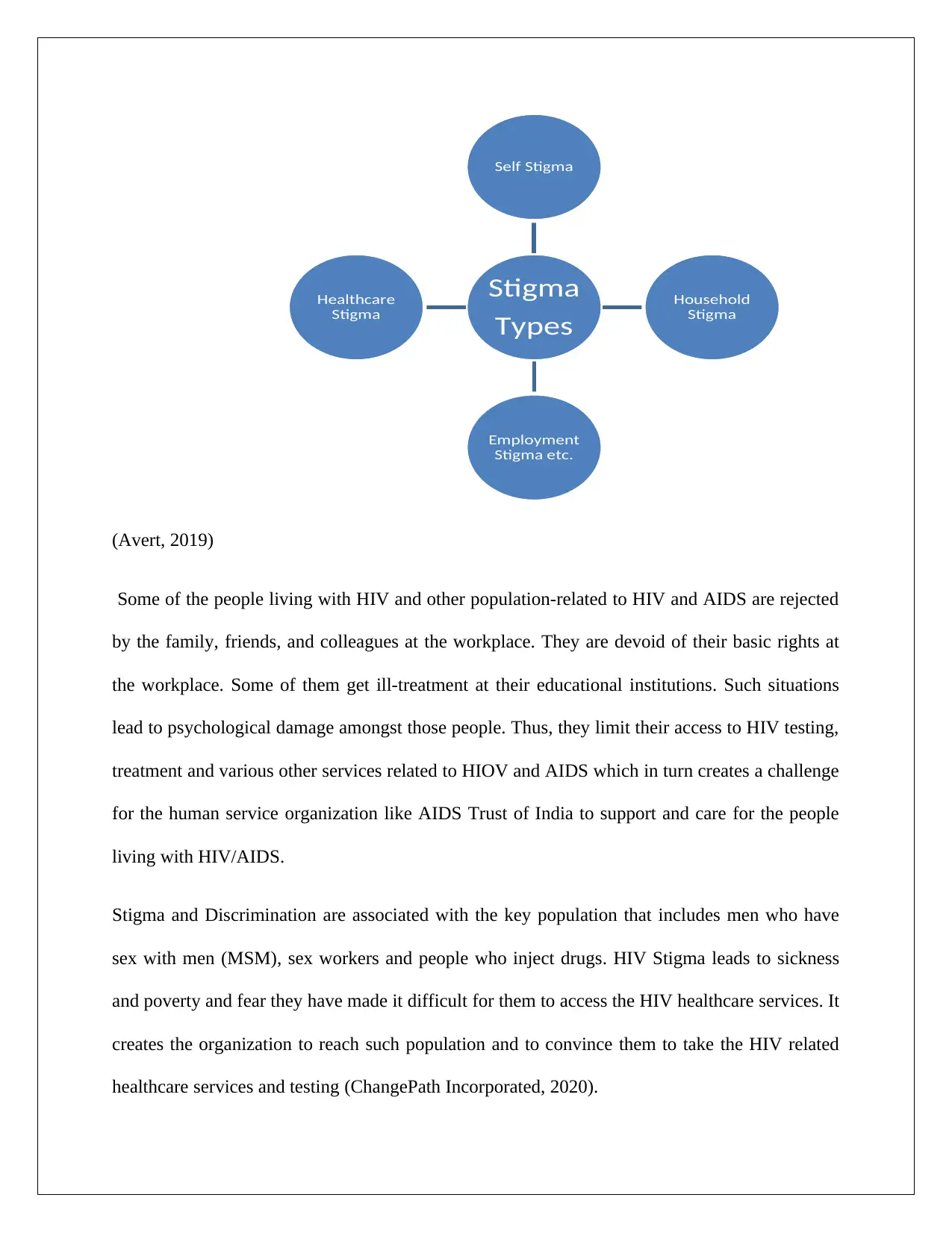
(Avert, 2019)
Some of the people living with HIV and other population-related to HIV and AIDS are rejected
by the family, friends, and colleagues at the workplace. They are devoid of their basic rights at
the workplace. Some of them get ill-treatment at their educational institutions. Such situations
lead to psychological damage amongst those people. Thus, they limit their access to HIV testing,
treatment and various other services related to HIOV and AIDS which in turn creates a challenge
for the human service organization like AIDS Trust of India to support and care for the people
living with HIV/AIDS.
Stigma and Discrimination are associated with the key population that includes men who have
sex with men (MSM), sex workers and people who inject drugs. HIV Stigma leads to sickness
and poverty and fear they have made it difficult for them to access the HIV healthcare services. It
creates the organization to reach such population and to convince them to take the HIV related
healthcare services and testing (ChangePath Incorporated, 2020).
Stigma
Types
Self Stigma
Household
Stigma
Employment
Stigma etc.
Healthcare
Stigma
Some of the people living with HIV and other population-related to HIV and AIDS are rejected
by the family, friends, and colleagues at the workplace. They are devoid of their basic rights at
the workplace. Some of them get ill-treatment at their educational institutions. Such situations
lead to psychological damage amongst those people. Thus, they limit their access to HIV testing,
treatment and various other services related to HIOV and AIDS which in turn creates a challenge
for the human service organization like AIDS Trust of India to support and care for the people
living with HIV/AIDS.
Stigma and Discrimination are associated with the key population that includes men who have
sex with men (MSM), sex workers and people who inject drugs. HIV Stigma leads to sickness
and poverty and fear they have made it difficult for them to access the HIV healthcare services. It
creates the organization to reach such population and to convince them to take the HIV related
healthcare services and testing (ChangePath Incorporated, 2020).
Stigma
Types
Self Stigma
Household
Stigma
Employment
Stigma etc.
Healthcare
Stigma
⊘ This is a preview!⊘
Do you want full access?
Subscribe today to unlock all pages.

Trusted by 1+ million students worldwide

Paraphrase This Document
Need a fresh take? Get an instant paraphrase of this document with our AI Paraphraser

(Avert,
2019)
2019)
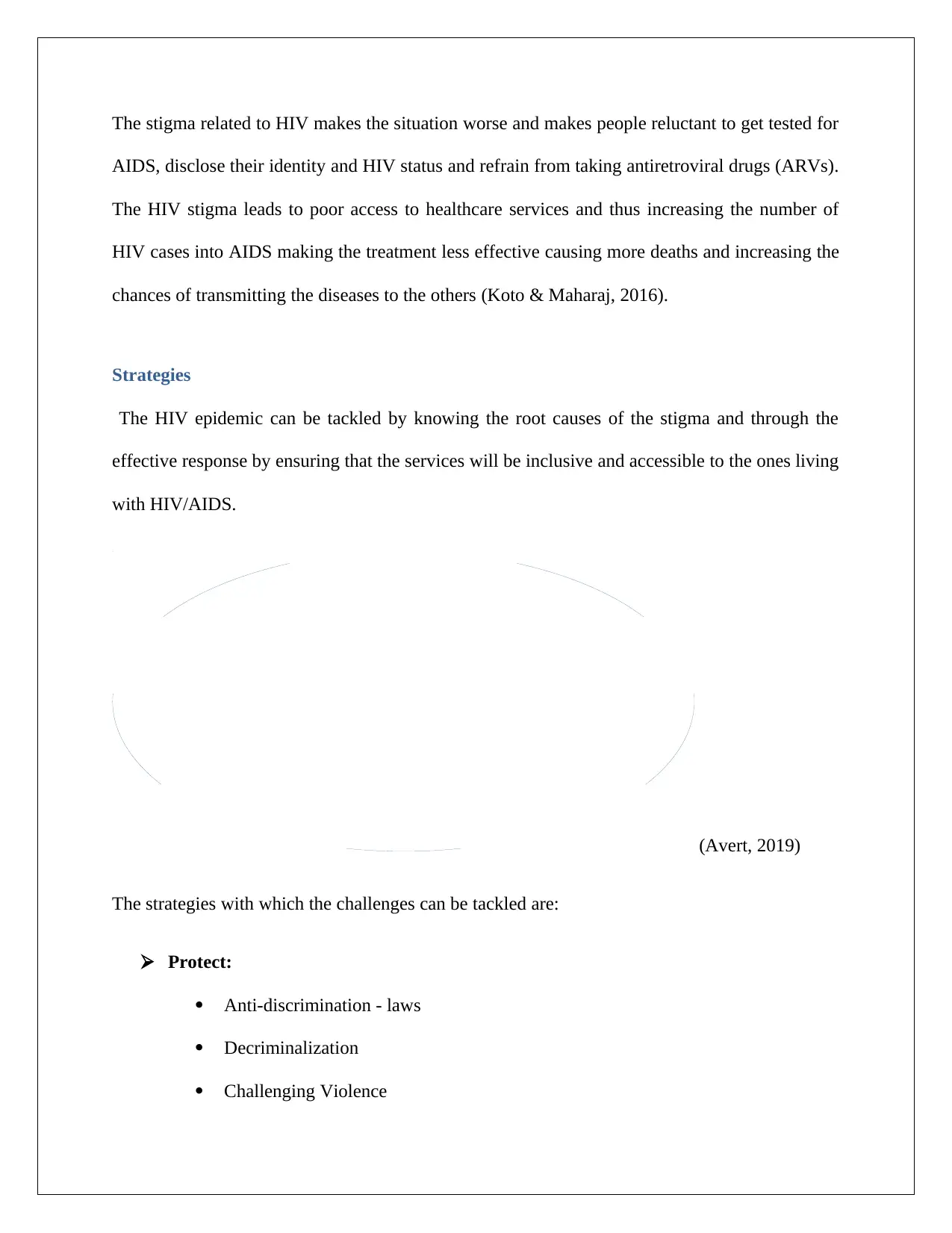
The stigma related to HIV makes the situation worse and makes people reluctant to get tested for
AIDS, disclose their identity and HIV status and refrain from taking antiretroviral drugs (ARVs).
The HIV stigma leads to poor access to healthcare services and thus increasing the number of
HIV cases into AIDS making the treatment less effective causing more deaths and increasing the
chances of transmitting the diseases to the others (Koto & Maharaj, 2016).
Strategies
The HIV epidemic can be tackled by knowing the root causes of the stigma and through the
effective response by ensuring that the services will be inclusive and accessible to the ones living
with HIV/AIDS.
(Avert, 2019)
The strategies with which the challenges can be tackled are:
Protect:
Anti-discrimination - laws
Decriminalization
Challenging Violence
ProtectIncludeEmpowerEducateAdvocateforAction
AIDS, disclose their identity and HIV status and refrain from taking antiretroviral drugs (ARVs).
The HIV stigma leads to poor access to healthcare services and thus increasing the number of
HIV cases into AIDS making the treatment less effective causing more deaths and increasing the
chances of transmitting the diseases to the others (Koto & Maharaj, 2016).
Strategies
The HIV epidemic can be tackled by knowing the root causes of the stigma and through the
effective response by ensuring that the services will be inclusive and accessible to the ones living
with HIV/AIDS.
(Avert, 2019)
The strategies with which the challenges can be tackled are:
Protect:
Anti-discrimination - laws
Decriminalization
Challenging Violence
ProtectIncludeEmpowerEducateAdvocateforAction
⊘ This is a preview!⊘
Do you want full access?
Subscribe today to unlock all pages.

Trusted by 1+ million students worldwide
1 out of 16
Related Documents
Your All-in-One AI-Powered Toolkit for Academic Success.
+13062052269
info@desklib.com
Available 24*7 on WhatsApp / Email
![[object Object]](/_next/static/media/star-bottom.7253800d.svg)
Unlock your academic potential
Copyright © 2020–2025 A2Z Services. All Rights Reserved. Developed and managed by ZUCOL.





